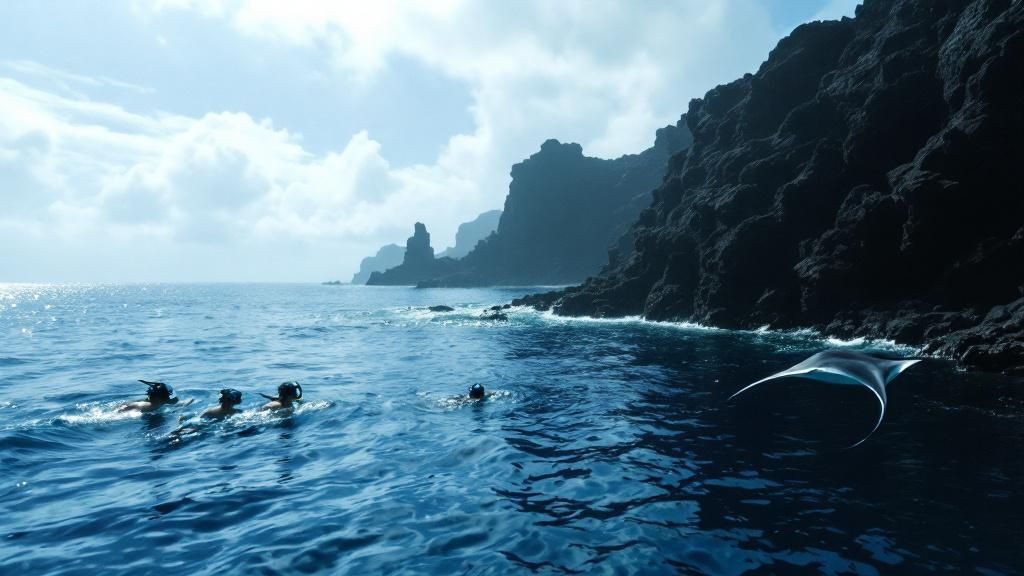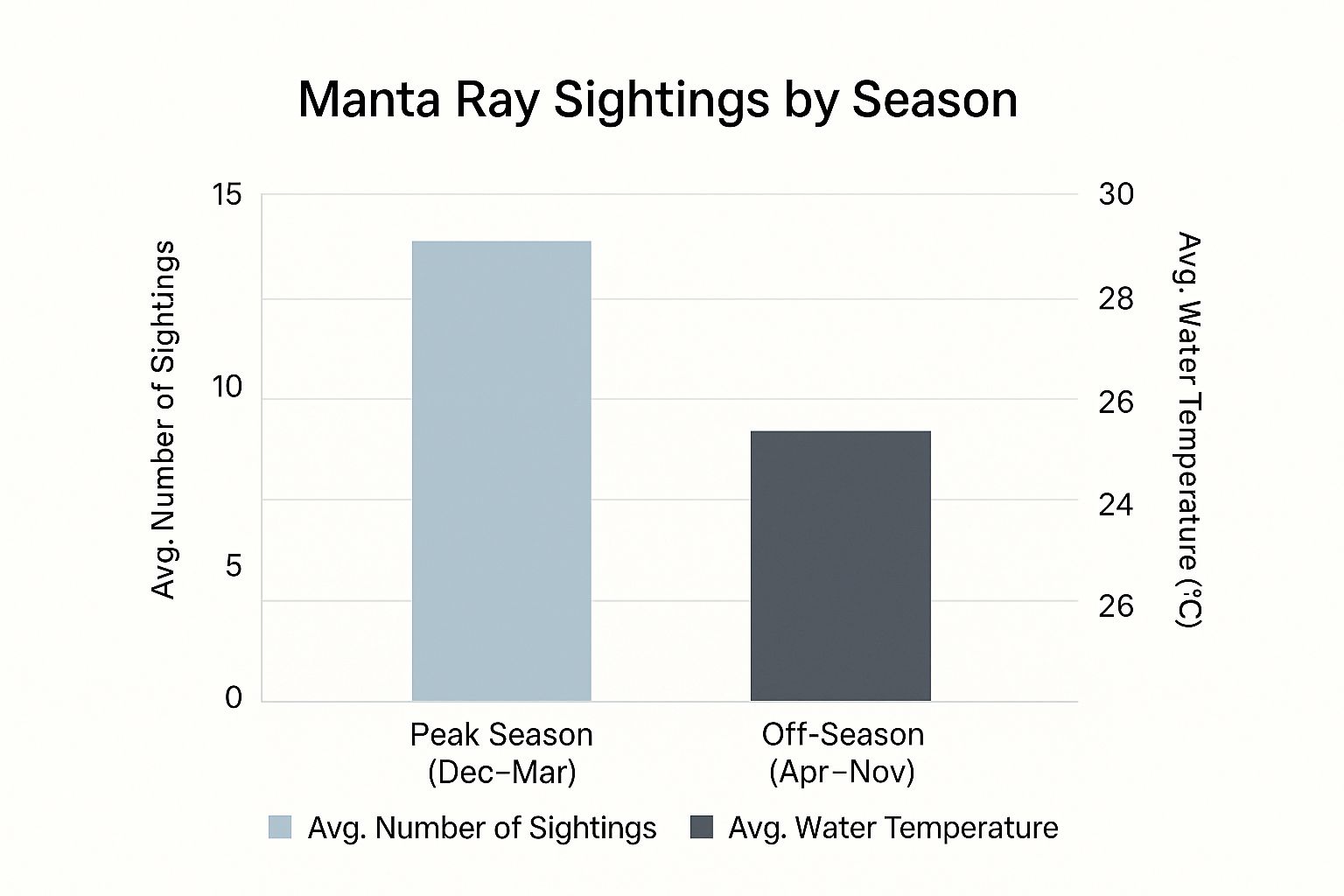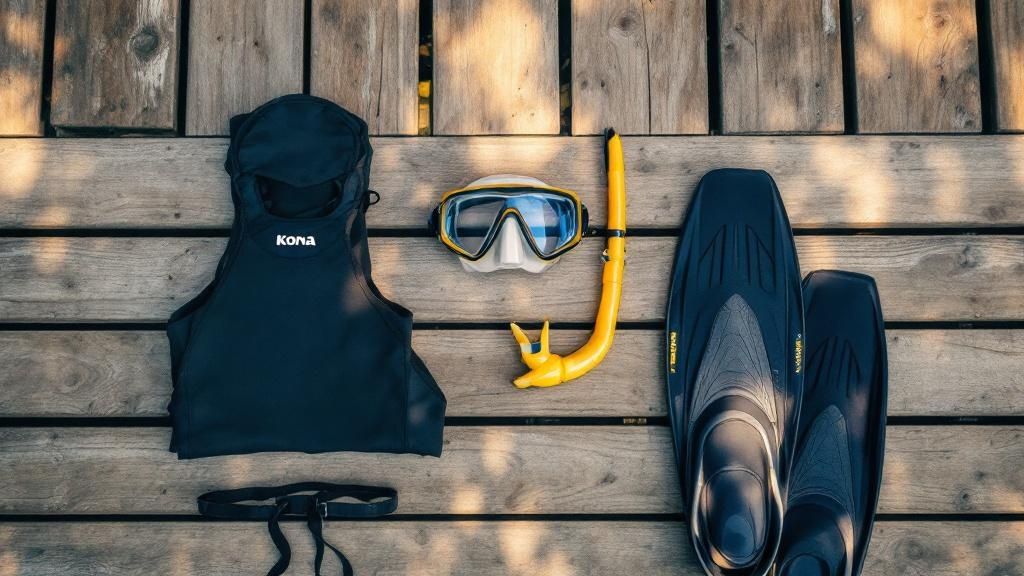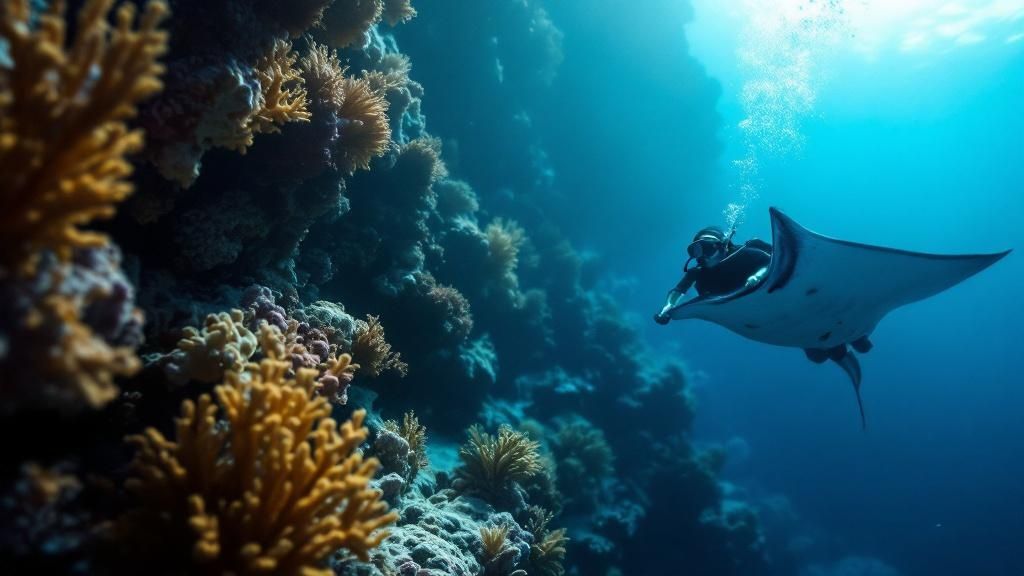Manta Ray Snorkel Kona: Your Complete Night Adventure Guide
- Byron
- Jun 12
- 14 min read
Why Kona's Manta Ray Night Snorkel Captivates Ocean Lovers
Imagine yourself floating in the warm Pacific, the stars a shimmering tapestry above. Then, a shadow emerges from the deep, growing larger and larger until a gentle giant with a 12-foot wingspan glides effortlessly beneath you. This isn't just another item to check off your vacation bucket list; it's a truly powerful encounter with the ocean's majesty. The Kona manta ray night snorkel is legendary, and for very good reason. It puts you right there, in the middle of the action, surrounded by creatures as curious about you as you are about them.
Unlike whale watching from a distant boat or jostling for space on a crowded reef tour, the manta ray night snorkel offers an unparalleled level of intimacy. These gentle giants, harmless filter feeders, seem genuinely interested in the humans who venture into their watery world. They often circle and loop around snorkelers, creating a sense of connection and shared wonder. It’s less like observing nature and more like participating in a delicate, underwater ballet.
So, what makes Kona such a manta ray haven? Think of the volcanic coastline as a giant buffet for these graceful creatures. The volcanic slopes plummet deep into the ocean, creating currents that bring nutrient-rich plankton to the surface. These plankton blooms, illuminated by the underwater lights used on the tours, become a feast for the mantas, and you get a front-row seat to the spectacle.
Choosing the Right Spot and Time
The timing and location of your snorkel are key to maximizing your experience. Choosing the right spot, like Manta Village or Manta Heaven, drastically increases your chances of a truly magical encounter. The Kona Coast on the Big Island of Hawaii is renowned for its high manta ray sighting success rate. Operators like Jack's Diving Locker report seeing mantas on 85-90% of their night excursions. This impressive statistic mirrors the overall success rate in the region and draws in roughly 80,000 manta ray snorkelers every year. Learn more about manta ray sighting statistics. Understanding the seasonal patterns and daily factors influencing manta ray activity levels can further enhance your chances of witnessing these captivating feeding rituals.
Kona's unique combination of natural wonder, close proximity to these gentle giants, and the otherworldly nighttime setting creates an unforgettable adventure. It’s the kind of experience that sticks with you long after you’ve packed your bags, a story you’ll find yourself sharing again and again.
Getting To Know Your Swimming Partners: Manta Ray Secrets

Before you slip into the water for your Kona manta ray night snorkel, let's dive into some fascinating facts about these gentle giants. They're far more than just large fish; they possess remarkable intelligence, unique personalities, and intricate social structures. Think of them as the ocean's wise elders, gracefully moving through their world and showing a surprising curiosity towards respectful human onlookers.
Decoding the Manta Ray Ballet
One of the most captivating parts of a manta ray snorkel is watching their mesmerizing feeding habits. Their graceful barrel rolls and loops, often compared to an underwater ballet, are far from random. These movements are actually strategic maneuvers to maximize their plankton intake. Imagine it like a precisely choreographed dance, where every twirl and swoop has a purpose: gathering the tiny organisms that make up the core of their diet.
Furthermore, every manta ray has a unique spot pattern on its underside, much like our fingerprints. This allows researchers, and even observant snorkelers, to identify individual mantas. Recognizing these patterns transforms the experience from simply watching to a personal encounter, allowing you to connect with specific individuals and appreciate their unique behaviors. For a deeper dive into this topic, check out Snorkeling With Manta Rays Big Island: Top Spots.
Communication and Curiosity
Manta rays communicate through a range of subtle cues, including body language and shifts in their wing movements. While scientists are still deciphering the intricacies of their communication, it's clear these gentle giants have a complex level of social interaction. Between 2009 and 2014, researchers meticulously documented manta ray sightings along the Kona Coast, tracking individuals and compiling monthly statistics. This data illuminated their movements within their home range. You can uncover more fascinating insights here. This detailed research gives us a much richer understanding of their behavior.
Manta rays often approach snorkelers with what seems like genuine curiosity. This isn't aggression, but rather an inquisitive nature that adds to the magic of the experience. By understanding their behaviors and respecting their natural rhythms, you can position yourself for the best possible views without disrupting their routines. This creates truly unforgettable encounters that benefit both the observer and the observed.
Selecting Your Perfect Manta Ray Snorkel Experience

This infographic gives you a snapshot of manta ray sightings and water temperatures. Notice how sightings stay pretty consistent throughout the year in Kona, but during peak season (December-March) you have a slightly higher chance of seeing more mantas, plus the water is warmer. While any time is a good time for a manta ray snorkel in Kona, those winter months offer a bit of an edge. For more in-depth info on tours, check out this helpful resource.
Just like choosing a restaurant, picking the right manta ray snorkel tour operator can dramatically affect your experience. Some restaurants are all about speed and volume, while others focus on crafting a special, memorable meal. The same goes for tours.
Key Considerations When Choosing a Tour Operator
Choosing the right tour goes beyond just the price tag. Here’s what to think about:
Commitment to Conservation: Look for operators invested in sustainable tourism. Do they participate in manta ray research or educational programs? It's like choosing a farm-to-table restaurant – supporting the local ecosystem makes the experience even better.
Group Size: A small group tour is like a private dining experience – more personalized attention from your guide and less disruption to the manta rays. Larger groups might be easier on the wallet, but can feel a bit impersonal.
Safety Protocols: Don't be afraid to ask about safety procedures, emergency plans, and guide certifications. It's like checking a restaurant's health rating – it gives you peace of mind knowing they prioritize your well-being.
Tour Formats and What to Expect
Tour formats vary, just like restaurant menus. Some tours are short and sweet, focusing solely on the manta ray encounter, while others might include sunset views or coastal cruises.
Intimate Small-Group Tours: These are for folks who want a more personalized, hands-on experience with fewer people and more interaction with the guides.
Budget-Friendly Larger Groups: A good choice if you’re looking for a more economical option but still want to witness the magic of the manta rays.
Private Charters: If you want the ultimate VIP experience, a private charter lets you customize the tour and enjoy it with your own group.
Practical Considerations and Hidden Costs
Like booking a flight where the advertised price doesn’t always include baggage fees, make sure you know what's included in the tour price. Some tours include extras like wetsuit rentals, underwater photography packages, or snacks. Ask upfront to avoid surprises.
Weather can also play a role. Responsible operators will reschedule or cancel tours if conditions are unsafe. Flexible booking policies are a good sign.
To help you compare different tour operators, we've put together this handy guide:
Kona Manta Ray Tour Comparison Guide Compare different tour operators, group sizes, prices, and included amenities to help choose the best manta ray snorkel experience
Tour Operator | Group Size | Duration | Price Range | Included Equipment | Special Features |
|---|---|---|---|---|---|
Example Operator 1 | 6-8 | 2 hours | $150-$180 | Mask, snorkel, fins, wetsuit | Small group, personalized attention |
Example Operator 2 | 10-15 | 1.5 hours | $120-$150 | Mask, snorkel, fins | Underwater photography available |
Example Operator 3 | 20-25 | 2 hours | $90-$120 | Mask, snorkel, fins, floatation device | Budget-friendly option |
Example Operator 4 | Private | Customizable | $500-$800 | All equipment included | Customizable itinerary, sunset views |
This table provides example data. Please consult individual tour operators for current pricing and details.
This table gives you a quick overview of what different operators offer. Notice the differences in group sizes, durations, and price ranges. Some even include special features like personalized attention or sunset viewing.
By considering these factors, you can choose a manta ray snorkel tour that not only delivers an amazing experience but also supports responsible tourism and protects these magnificent animals.
Setting Yourself Up For Manta Ray Magic

Your Kona manta ray snorkel adventure really begins before you even get your feet wet. Think of it like a musician preparing for a big performance. The tuning, the practice, the mental preparation – it all leads to a more harmonious experience. Getting yourself ready logistically, physically, and mentally allows you to truly soak in the magic once you're in the water. If you're still looking for the perfect tour, browsing options like those on All Tours can be a great starting point.
Gearing Up for the Encounter
Most tour operators will provide the basics: mask, snorkel, fins, and a wetsuit. But, much like a seasoned hiker prefers their own well-worn boots, using your own snorkel gear can greatly increase your comfort and confidence. That familiar feel can make a big difference in your overall experience. Beyond the in-water essentials, packing a light sweater for the boat ride back is a fantastic idea. After being in the cool night water, you'll appreciate that extra layer. A quick-drying towel and a dry set of clothes are also smart additions to your snorkel bag.
Physical Preparation: More Than Just Knowing How to Swim
Knowing how to swim is, of course, a prerequisite. However, prepping your body a little beforehand can truly enhance your experience. Think of it like a pre-workout warm-up – a few stretches and practice movements to get you ready. Practicing with your snorkel gear in a pool can build confidence and get you comfortable with the equipment. Some light stretching can also increase flexibility and help prevent muscle cramps.
Mental Preparation: Embracing the Night
For some, the idea of night snorkeling might feel a little intimidating. But with the right mindset, you can easily shake off those nerves. Picture it as a peaceful meditation in the water, focusing on your breath and the gentle rhythm of the ocean around you. Visualizing yourself calmly floating alongside the manta rays can help ease any apprehension. Understanding the different phases of the tour—the boat ride, the briefing, entering the water, and finally, the manta ray encounter—helps manage expectations and build excitement.
Practical Logistics: Smooth Sailing From Start to Finish
Just like the stage crew behind a theatrical production, pre-tour logistics are key to a smooth and enjoyable experience. Eating a light meal beforehand can help prevent seasickness, but it's best to avoid heavy, greasy foods that might upset your stomach. Arranging your transportation to the departure point ahead of time is also recommended, as is having secure storage for your valuables. These small but important details allow you to fully focus on the main event: the manta ray magic that awaits.
Your Complete Manta Ray Adventure: Sunset To Starlight
Your manta ray adventure begins well before you even dip a toe in the water. Imagine yourself on a boat, the Kona sun melting into the ocean, painting the sky in vibrant oranges and reds. It’s this scenic journey that sets the stage for the magic that’s about to unfold beneath the surface. Understanding the rhythm of the evening allows you to truly appreciate each moment, from the anticipation on the boat to that very first, unforgettable glimpse of a manta ray.
Preparing for the Encounter
As your boat nears the snorkel site, usually Manta Village or Manta Heaven, the crew gets to work. They carefully lower special underwater lights, like tiny underwater spotlights, into the ocean. These aren't just for show; they're essential for attracting plankton, the main food source for manta rays. It's like setting up a delicious buffet to entice these gentle giants. Drawn by the light, the plankton gather, creating a shimmering cloud that anticipates the mantas' arrival.
This is where patience becomes a virtue. Sometimes, the mantas appear almost instantly, eager for their plankton dinner. Other times, they take a bit longer to gather. But this waiting period isn't wasted. It builds a sense of excitement and gives you a chance to soak in the tranquility of the ocean at night, with the stars twinkling above.
Entering the Water and the First Sightings
Sliding into the dark Pacific Ocean can be a surreal experience. At first, you’re enveloped in darkness. Then, as your eyes adjust to the soft glow of the underwater lights, a hidden world reveals itself. Picture this: the ethereal luminescence of the plankton, the shadowy figures of your fellow snorkelers, and then, a massive, graceful form emerges from the deep. A manta ray, gliding effortlessly through the water, its wingtips almost kissing the surface.
The popularity of manta ray snorkeling in Kona isn’t just about the high probability of sightings; it's about the unique and deeply personal nature of the experience. Participants are often left speechless, filled with awe at these magnificent creatures with wingspans reaching up to 12 feet, performing their feeding rituals just inches away. Discover more insights. For a truly comprehensive overview of the whole night adventure, you might find this helpful: Manta Ray Night Snorkel Kona: Your Complete Hawaii Night Adventure.
The Manta Ray Ballet and Shared Wonder
Manta rays aren't just passive diners; they're active performers in a captivating underwater ballet. They execute graceful barrel rolls and loops, their movements both elegant and incredibly efficient as they gather plankton. Some nights are a flurry of activity, with multiple mantas circling and feeding, creating an electric atmosphere. Other nights are more serene, offering intimate encounters with individual rays. This variety is all part of the natural rhythm of manta feeding behavior, adding an element of surprise to every snorkel trip.
These magical encounters typically last for around 30-45 minutes, a timeframe that feels both fleeting and timeless. Sharing this wonder with other snorkelers makes the experience even richer. There’s a palpable sense of shared awe, a collective appreciation for the beauty unfolding before your eyes. It connects you not just to the manta rays, but to fellow ocean lovers, creating a truly memorable social experience.
Protecting Paradise: Safety and Conservation In Action

Swimming with manta rays during a manta ray snorkel Kona adventure is a real privilege. But with this privilege comes a significant responsibility: protecting both yourself and these magnificent creatures. Think of it like being a guest in someone's home – you want to be respectful and safe. This section covers the key aspects of safety and conservation that make this experience enriching and sustainable.
Safety First: Beyond the Basics
While knowing how to swim is essential, manta ray night snorkeling requires more than just basic skills. It's important to understand how to handle the unexpected, like a sudden current shift or a problem with your gear. Knowing what to do if you get separated from your group is also crucial. Most reputable operators use buddy systems and give clear instructions on how to regroup. For added safety during your manta ray snorkel adventure, a reliable communication device like the GME GX625 5W VHF Marine Radio can provide peace of mind.
Being aware of changing ocean conditions, like increasing swell or a drop in visibility, is another important part of staying safe. Your guides are trained to assess these conditions and will always prioritize your well-being. However, developing your own awareness of the ocean makes you a more informed and proactive participant.
Manta Ray Etiquette: Respectful Interactions
Imagine you’re visiting a gallery filled with delicate artwork. You wouldn’t dream of touching the pieces or making a lot of noise. The same principle applies when interacting with manta rays. Touching them is strictly forbidden. Their skin has a protective mucus layer, vital to their health, which is easily disrupted by human touch. Even seemingly harmless contact can cause damage.
Positioning yourself thoughtfully in the water allows for the best viewing without disturbing the manta rays' feeding. Think of it like watching a hummingbird at a feeder – you’d keep a respectful distance so you don’t frighten it away. Similarly, keeping a comfortable distance from the mantas lets them continue feeding naturally.
Creating a calm atmosphere helps these gentle giants feel comfortable around people. Avoid sudden movements or loud noises. Just like being a respectful guest in someone’s home, staying quiet and composed allows the mantas to feel at ease and behave naturally.
To summarize the key do's and don'ts, let's take a look at the following guidelines:
Manta Ray Interaction Guidelines: Essential do's and don'ts for respectful manta ray encounters, including safety protocols and conservation practices.
Do | Don't | Why It Matters | Consequences |
|---|---|---|---|
Stay a safe distance | Touch the manta rays | Their skin is covered in a protective mucus layer crucial for their health. | Disrupts their mucus layer, making them vulnerable to infections and diseases. |
Follow guide instructions | Make sudden movements | Manta rays are sensitive to disturbances and sudden movements can scare them. | May cause the manta rays to flee the area, disrupting their natural behavior. |
Be quiet in the water | Make loud noises | A calm environment keeps the manta rays relaxed and allows for natural feeding behaviors. | Can disrupt their feeding and cause stress. |
Respect their space | Chase or harass them | Allows them to continue their natural behavior undisturbed. | Creates a negative experience for both the manta rays and other snorkelers. |
These guidelines ensure a safe and positive encounter for both you and the manta rays. By following these simple rules, we contribute to the long-term health and well-being of these amazing animals.
Conservation in Action: Protecting Future Encounters
Manta ray populations around the world face many threats, from accidental fishing (bycatch) to habitat loss. Responsible tourism offers vital protection. When you participate in a manta ray snorkel Kona tour, you directly support ongoing research. Scientists use data collected during these tours to track manta ray movements, understand their behavior, and monitor population health. For more information on the manta ray snorkel experience, visit this link.
This means your experience isn’t just passive observation; it's an active contribution to manta ray conservation. Supporting sustainable tour operators ensures that part of your fee goes directly towards protecting these animals. This creates a cycle where tourism fuels conservation, ensuring that future generations can also experience the magic of swimming with manta rays. By following responsible guidelines and supporting conservation efforts, we can all help protect these gentle giants for years to come.
Maximizing Your Once-In-A-Lifetime Manta Ray Encounter
Booking your manta ray snorkel Kona adventure is the first step. But the real magic, like any great trip, is in the details. Think of it like the difference between simply eating a meal and savoring every bite. A few insider strategies can transform your experience from memorable to truly extraordinary.
Positioning and Movement: The Art of Manta Ray Viewing
Imagine a darkened theater, the anticipation building before a show. Your seat, of course, affects your view. Similarly, positioning yourself strategically in the water maximizes your manta ray viewing. Experienced guides will lead you to the best spots, but understanding the dynamics helps you anticipate the action. The mantas, attracted by the plankton, will congregate around the light source. Stay near the light – without blocking it – for the best views.
Movement should be minimal and graceful. Think of yourself as a visitor in a hushed art gallery, not wanting to disturb the masterpieces. Sudden movements can frighten the manta rays. Instead, aim for neutral buoyancy, drifting calmly with the current. This allows for a more natural encounter, encouraging the curious mantas to approach you. For a deeper dive into preparing for your adventure, check out our Manta Ray Snorkel Kona: Complete Night Adventure Guide.
Timing and Photography: Capturing the Magic Without Missing It
While manta rays grace Kona's waters year-round, certain times provide even better viewing. Just as a seasoned gardener knows the optimal time for blooms, understanding seasonal and daily patterns enhances your experience. For example, the calmer waters and increased plankton of the summer months often mean higher manta ray activity. It's also important to be aware of how our actions impact the ocean. For more on protecting our marine environments, check out this resource: How To Prevent Marine Pollution Essential Steps To Act Now.
Capturing these moments with underwater photography is tempting, but remember to be present. Your eyes are your best lens; absorb the unfolding beauty firsthand. Photos preserve a single moment, but being truly present allows you to internalize the whole experience. Choose your shots carefully, and know when to put the camera down and simply be captivated.
Beyond the Encounter: Extending the Magic
The impact of your manta ray snorkel should last longer than your suntan. Like a powerful story that resonates long after you’ve heard it, mindful reflection can extend the magic. Sharing your experience responsibly—through stories and photos—helps others appreciate these magnificent creatures and their delicate ecosystem.
Staying connected with the wider community of manta ray enthusiasts and conservation supporters keeps your passion alive. This might involve supporting organizations dedicated to marine research and conservation, or simply continuing to learn about these gentle giants. Your manta ray encounter can be a gateway to deeper ocean exploration and marine conservation involvement, enriching not just your life, but the lives of these incredible animals.
Ready for your own unforgettable manta ray adventure? Book your Manta Ray Night Snorkel Kona Hawaii Tours today!
Comments